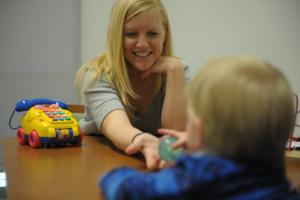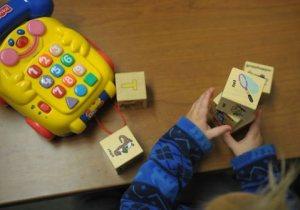By Jessica Bradshaw
As an Autism Science Foundation predoctoral fellow, I had the privilege of pursuing the answers to fascinating questions about the development of autism spectrum disorder in the first year of life. My research on very early interventions to encourage the development of pivotal social-communicative behaviors led me to questions of outcome measurement. How are we measuring such a complex system of behavior in young infants? How do we know if the intervention is working? How do we even know whether to intervene in the first place? How can we modify already well-established ASD interventions to work for the youngest infants? The questions became endless.
In an effort to make more sense of these seemingly infinite questions, I gathered all the research studies that implemented very early intervention for infants with or at-risk for autism from birth to 24 months of age. Only nine studies had scientifically documented the impact of that intervention in this very young population. Only nine studies! In reviewing and analyzing these studies, we found some answers about how to identify and intervene in early infancy and, of course, came up with even more questions.

Jessica Bradshaw works with a client.
How do we know when to intervene?
Most researchers seemed to determine clinical concern for ASD based on both standardized measures (e.g., ADOS) and expert clinical judgment. Because toddlers typically begin using language between 12-24 months, delayed language is a primary risk factor for ASD around age two. At this age expert developmental clinicians were also able to notice atypical sensory and motor behaviors that may be associated with ASD. Infants under 12 months, however, proved to be tricky. Language is not expected at this age and repetitive behaviors and sensory interests are a part of typical infant development! Discerning symptoms of autism in these young infants have been notoriously difficult for researchers.
What are the treatments for infants and toddlers with or at-risk for ASD?
The use of behavioral strategies for improving social communication and decreasing challenging behaviors is the most established form of treatment for individuals with ASD thus far. As it turns out, intervention for infants is no different. Nearly all studies used a typical behavioral framework: provide an opportunity for the behavior (antecedent), wait for the infant to respond (behavior), and reward the child (consequence). Of course the studies did not report a standard “ABA” protocol in which the infant is sitting at a table while an adult presents them with different tasks. In my own studies using Pivotal Response Treatment (PRT), treatment sessions for children 0-5 years take place on the floor engaging in whatever activity motivates the child, like peek-a-boo or singing songs. In PRT, we find that motivating the child to interact and socially engage is pivotal in ASD intervention. It is easy to see how this type of naturalistic treatment strategy might be especially suited for infants.

Does it work?
Ah, the million dollar question. These 9 studies were encouraging, but as for autism outcome – we need more research. Infants and toddlers tended to improve on target goals, but there was a lot of variability, calling into question the exact ingredients of treatment that are leading to improvements. Importantly, infants who started intervention earlier were found to make greater gains, re-confirming other findings (and our suspicion) that earlier intervention is better. Toddlers who received more hours of intervention also benefited more from treatment. Parents of all studies reported high satisfaction and enjoyment with these interventions, despite heavy parent involvement. It can be difficult for parents to interact with their toddler at-risk for ASD who is less socially responsive, and spending what can amount to 30-40 hours a week delivering interventions at home is exhausting. Interventions addressed this issue by teaching parents how to play and interact such that their child will be more interactive and engaged – and parents actually had fun doing it! This finding is key. The more we make our interventions feasible and enjoyable for parents, while also reducing parent stress, the more parents will use the treatment techniques and the more the entire family will benefit.
Prevention and intervention techniques for the youngest infants are rapidly growing and findings are burgeoning. These interventions are moving beyond the classic “ABA” model and incorporating elements related to developmental theory, self-regulatory processes, family systems, and parent-infant synchrony. Recently, a paper was published by leaders in the field who agree that sometimes the names of the interventions can be artificial, since most are based in the same evidence-based methods of behavioral learning and developmental sciences. Schreibman et al. (2015) termed these interventions “Naturalistic Developmental Behavioral Interventions” and urge researchers to continue refining the active ingredients of treatment and testing its long-term impact in order to develop interventions that are most efficient and effective for families.
